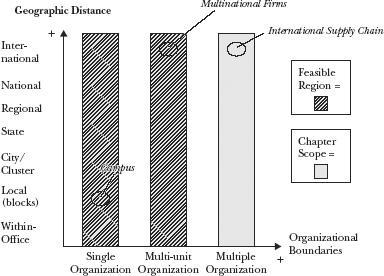Organizational learning and knowledge transfer are central to the performance and prosperity of organizations. Organizational learning is a process through which organizations interpret their experience, which can enable them to improve their performance and adapt to their environments. Organizations that are able to learn and transfer the resultant knowledge throughout their establishments are more successful than organizations that are less adept at organizational learning and knowledge transfer (Argote and Ingram, 2000; Teece, Pisano, and Shuen, 1997).
New organizational forms that involve geographic distribution of organizational units pose challenges to organizational learning and knowledge transfer. Over the past few decades there has been a growing fragmentation and internationalization of firms’ productive activities (Feenstra, 1998; Gereffi, Humphrey, and Sturgeon, 2005). We discuss the fragmentation and internationalization trends separately.
A number of changes over the past three decades have led to the increased fragmentation and, thereby, distribution of productive activity. Continued improvements in an ever-growing variety of electronic-based communication (such as email and video conferencing) and coordination media (including online collaborative tools such as Google documents) are increasing the viability of distributing teams across geographic distance and firm boundaries. In addition, advances in information technology (IT), such as enterprise resource planning and computer-aided design systems, are reducing traditional reliance on face-to-face communications.
At the same time, the last three decades have seen a dramatic change in the structure of many US industries. In the 1950s, 1960s, and early 1970s, much research and development was housed within corporate laboratories such as Bell Laboratories, GE Research, and Xerox Parc. By the 1980s and 1990s, key advantages to networked small and medium-sized enterprises appeared. Such enterprises were quicker, more flexible, and more innovative than their larger, slower-moving counterparts (Piore and Sabel, 1984; Pavitt and Townsend, 1987; Powell, 1990). Today, many firms outsource their innovation to universities and small firms through technology alliances and acquisitions (Cohen and Levinthal, 1990; Lamb and Spekman, 1997; Chesbrough, 2003). As a consequence, complex networks of firms, universities, and government laboratories are critical features of many industries, especially in fields with rapid technological progress, such as computers, semiconductors, pharmaceuticals, and biotechnology (Powell and Grodal, 2005).
Along with increased opportunities to fragment and distribute firm activities has come increased globalization of those activities. While globalization is as old as international trade (Hirst and Thompson, 1996), in recent years the extent and nature of globalized activities have changed dramatically. Empirical research through the 1980s broadly supported the theory that firms would initially innovate and locate production in their home country, and only move activities overseas as products commoditized and matured (Vernon, 1966; Mullor-Sebastian, 1983; Antras, 2004). Today, however, more and more firms are ‘born global’ (Oviatt and McDougal, 1994). These international new ventures are business organizations that from their very inception seek to derive competitive advantage from the use of resources and the sale of outputs in multiple countries (Oviatt and McDougal, 1994). At the same time as young, small firms are becoming increasingly international, pre-existing multinational firms have also expanded their global activities (Feenstra, 1998; Gereffi, Humphrey, and Sturgeon, 2005; Lewin and Couto, 2007). This distribution of employees across spatial, temporal, and national boundaries brings new challenges as well as opportunities for organizational learning and knowledge transfer.
From the fragmentation and internationalization of productive activity arise a variety of possible organizational forms. As shown in Figure 29.1, these organizational forms can be distinguished along two axes. The horizontal axis is the organizational boundary; the vertical axis is geographic distance. On the organizational boundary axis, productive activities can occur within a single organization, within multi-unit organizations such as franchises and chains (Baum and Greve, 2001), and within multiple organizations including different firms (e.g. supply chain) and mixed organizational types such as firms, universities, and government laboratories. On the vertical axis, distances can range from those within an office space (Allen, 1977) to within a few city blocks (Allen, 1977) to within a city (Marshall, 1890; Porter, 1990) to spanning state, national, or international boundaries.
Figure 29.1 Organizational Forms Spanning Geographic Distance and Organizational Boundaries

This chapter analyzes how organizational learning and knowledge transfer are affected by the geographic distribution of organizational units. We focus on studies that examine the effect of geographic distribution on learning and knowledge transfer processes and outcomes. In focusing on geographic distribution, our analysis encompasses both single- and multi-unit organizational forms. We leave the discussion of learning and knowledge transfer across different organizations to other studies.
In the subsequent sections, we first define organizational learning and knowledge transfer and then discuss a framework for analyzing them. We then describe geographic distribution, its underlying dimensions, and the challenges and opportunities it poses for organizational learning and knowledge transfer. We next turn to a discussion of the context and how it facilitates or impedes learning and knowledge transfer in geographically distributed organizations. We conclude the chapter with a discussion of future research directions that are likely to be fruitful.
